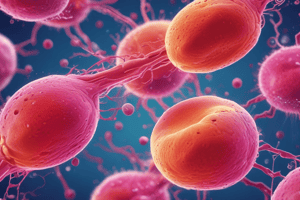Podcast
Questions and Answers
Which of the following laboratory tests can help diagnose hypochromic anemia and indicate bleeding?
Which of the following laboratory tests can help diagnose hypochromic anemia and indicate bleeding?
- X-ray studies with barium
- Occult blood in the stools
- CBC (correct)
- Endoscopy
The liver has a dual blood supply from the hepatic artery and the aorta.
The liver has a dual blood supply from the hepatic artery and the aorta.
False (B)
What is the function of the liver in removing bilirubin?
What is the function of the liver in removing bilirubin?
The liver removes, conjugates, and secretes bilirubin into the bile.
The liver produces approximately _______ mL of bile daily.
The liver produces approximately _______ mL of bile daily.
Match the following liver functions with their descriptions:
Match the following liver functions with their descriptions:
What is the primary function of the portal vein?
What is the primary function of the portal vein?
The liver is responsible for the metabolism of ammonia.
The liver is responsible for the metabolism of ammonia.
What is the name of the functional units of the liver?
What is the name of the functional units of the liver?
What is one of the functions of the liver mentioned in the content?
What is one of the functions of the liver mentioned in the content?
Liver failure can occur suddenly due to massive hepatic destruction.
Liver failure can occur suddenly due to massive hepatic destruction.
What is the term for a decrease in bile flow through the intrahepatic bile ducts?
What is the term for a decrease in bile flow through the intrahepatic bile ducts?
What percentage of hepatic functional capacity must be lost before hepatic failure occurs?
What percentage of hepatic functional capacity must be lost before hepatic failure occurs?
Cirrhosis represents the end stage of chronic liver disease, characterized by the replacement of normally functioning liver tissue by ________________ tissue.
Cirrhosis represents the end stage of chronic liver disease, characterized by the replacement of normally functioning liver tissue by ________________ tissue.
Match the following terms with their descriptions:
Match the following terms with their descriptions:
Jaundice occurs when bilirubin accumulates in the blood due to excessive red blood cell destruction.
Jaundice occurs when bilirubin accumulates in the blood due to excessive red blood cell destruction.
What is the term for the central nervous system manifestations of liver failure, characterized by neural disturbances ranging from a lack of mental alertness to coma and convulsions?
What is the term for the central nervous system manifestations of liver failure, characterized by neural disturbances ranging from a lack of mental alertness to coma and convulsions?
What is gastritis?
What is gastritis?
Chronic gastritis is characterized by the presence of grossly visible erosions.
Chronic gastritis is characterized by the presence of grossly visible erosions.
What are some factors that may contribute to the development of chronic gastritis?
What are some factors that may contribute to the development of chronic gastritis?
Acute gastritis is most commonly associated with local irritants such as _______________________.
Acute gastritis is most commonly associated with local irritants such as _______________________.
What is a possible outcome of chronic gastritis?
What is a possible outcome of chronic gastritis?
Match the following terms with their descriptions:
Match the following terms with their descriptions:
Flashcards are hidden until you start studying
Study Notes
The Hepatobiliary System
- The hepatobiliary system consists of the liver, gallbladder, and bile ducts.
- The liver has a dual blood supply, receiving blood from the hepatic artery and the portal vein.
- The lobules are the functional units of the liver.
- The portal circulation carries blood from the gastrointestinal tract, spleen, and pancreas to the liver before returning to the heart.
Functions of the Liver
- Metabolic functions include: • Carbohydrate metabolism (glycogenesis, glycogenolysis, and gluconeogenesis) • Conversion of ammonia to urea • Metabolism of drugs and hormones (steroids)
- The liver removes, conjugates, and secretes bilirubin into bile.
- The liver is responsible for protein synthesis, including the production of albumin and coagulation factors.
- The liver produces approximately 600-1200 mL of bile daily, which contains bile salts essential for digestion and absorption of fat-soluble vitamins.
Gastritis
- Gastritis is inflammation of the gastric mucosa, which can be acute or chronic.
- Acute gastritis is a transient inflammation associated with local irritants such as bacterial endotoxins, caffeine, alcohol, and aspirin.
- Chronic gastritis is characterized by the absence of grossly visible erosions, chronic inflammatory changes, and atrophy of the glandular epithelium of the stomach.
Cholestasis
- Cholestasis is a decrease in bile flow through the intrahepatic bile ducts, leading to destructive liver changes and an accumulation of bile components in the blood.
- Jaundice occurs when bilirubin accumulates in the blood due to excessive red blood cell destruction, failure of the liver to remove and conjugate bilirubin, or obstructed biliary flow.
Liver Failure
- Liver failure can result from sudden and massive hepatic destruction or progressive damage to the liver.
- At least 80-90% of hepatic functional capacity must be lost before hepatic failure occurs.
- Causes of liver failure include fulminant hepatitis, alcoholic cirrhosis, and cancer liver or extensive metastasis.
Hepatic Encephalopathy
- Hepatic encephalopathy refers to central nervous system manifestations of liver failure.
- It is characterized by neural disturbances ranging from a lack of mental alertness to confusion, coma, and convulsions.
- A very early sign of hepatic encephalopathy is a flapping tremor.
- It is due to the accumulation of neurotoxins (ammonia) in the blood because the liver has lost its detoxifying capacity.
Studying That Suits You
Use AI to generate personalized quizzes and flashcards to suit your learning preferences.



